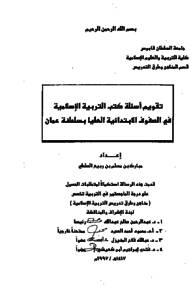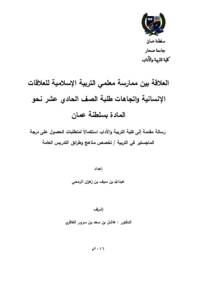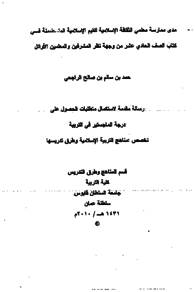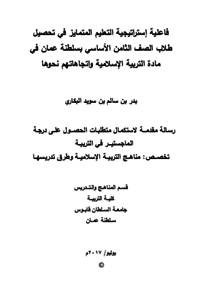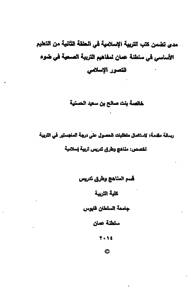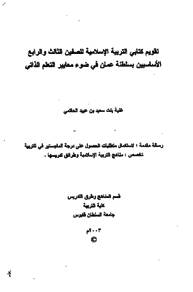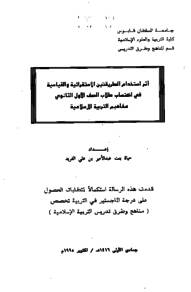Document
تقويم أسئلة كتب التربية الاسلامية في الصفوف الابتدائية العليا بسلطنة عمان
Publisher
جامعة السلطان قابوس
Gregorian
1997
Language
Arabic
Subject
English abstract
This study aimed to evaluate the concluding questions presented at the end of the lessons in the Islamic Education textbooks for the fourth , fifth and sixth grade levels of the Omani primary school. The research questions were as follows :
1 - To what extent do the Islamic Education question for the upper primary school classes conform with the essential specifications of a good question ?
2- What are the objectives covered by the Islamic Education questions in the upper primary school classes in the cognitive, affective and psycho - motor domains ?.
3 - To what extent do the Islamic Education questions in the upper primary classes conform with the criterion of comprehensiveness ?
4- To what extent do the Islamic Education questions in the upper prinary classes conform with the criterion of balance ?.
In order to reach an appropriate answer to the first question above, the specifications for a good question formation were identified by the researcher . Then these specifications were applied to a random specimen of the questions in the three textbooks. The goal of this application was to discover how far such specifications were conformed with in the questions. In an attempt to ensure the validity of this measure , the above - mentioned specimen questions were reviewed by a panel of referees who seconded the researcher's conclusion regarding the specimen questions conformity with the essential specifications. In order to ensure the reliability of this measure , the specimen questions were reviewed by a panel of referees. Then they were tested for reliability using the Holsti Formula . The reliabity coefficient of both essay and objective questions of all varieties ranged from (0.60 ) to ( 1.00). As for the second question , a random specimen of questions was selected and then classified according to the domain and level that they represented . In order to ensure the validity of this classification, it was reviewed by a panel of referees and steps were taken to incorporate their suggeste modifications. Regarding reliability , the specimen questions were reviewed by a panel of referees in accordance with the above-mentioned formula's reliability formula . The coefficient obtained ranged from (0,81 ) to (0.94). In response to the third question, a random specimen of the behavioural objectives included in the teachers' books for the three calsses was selected and then classified in accordance with its respective domain and level . In order to ascertain the validity of the classification, the specimen objectives were reviewed by a panel of referees whose recommended modifications were incorporated thereafter. As for reliability , the specimen objectives were reviewed by a panel of referees. The reliability coefficient was found to be (0.60 ).Subsequently, the classification was applied to the teachers' books for the three classes and a comparison with the objectives covered by the questions was attempted . In response to the fourth question , a questionnaire was presented to a panel of referees to identify the relative weighting which ought to be given to each domain and each level, and the percentages were computed . Then a comparison between these percenages and the percentages of the objectives covered by the questions was attempted . The main findings of the study were as follows:
1 - All questions in the three textbooks under investigation measure the objectives they purport to measure in the cognitive domain. The questions, however, do not cover either the affective or the psycho-motor domain .
2- Even in the cognitive domain, emphasis was laid upon two levels , i.e. recall and comperehension. (91.61%) of the questions of the fourth class textebook measure recall, and (8.39%) measure comprehension. (97.99%) of thquestions of the fifth class textbook measure recall, and (2.01%) measure comprehension .(97.16%) of the questions of the sixth class textbook measure recall, and (2.84%) measure comprehension. Accordingly, the questions can be judged as both uncomprehensive and unbalanced
3 - The three textbooks conform with the essential specifications of a good essay question formation at very high rates which reached ( 94.88%) for the fourth class textbook , (92,01%) for the fifth class textbook , and ( 88.98%) for the sixth class textbook
4- The three textbooks were generally weak as far as the matching - type of questions were concerned , reaching (40%) in the fourth class textbook , (66.66%) in the fifth class textbook and (50% )in the sixth class textbook .
-
-
5- The three textbooks confine themaelves too strictly to the vocabulary of the textbook in the completion questions, This is an undesirable feature of questions. Unless the question is in connection with a Quranic and Hadith text .
The study ended with a number of recommendations including the revision of the questions used in the Islamic Education textbooks of the upper classes of the primary school in an attempt to achieve the essential balance in the cognitive , affective and psycho - motor domains .
Description
رسالة جامعية
Member of
Resource URL
Arabic abstract
هدفت هذه الدراسة إلى تقويم الأسئلة الختامية المثبتة في نهاية دروس كتب التربية الإسلامية المقررة في الصفوف الابتدائية العليا : الرابع، والخامس ، والسادس، وذلك من خلال الإجابة عن الأسئلة التالية : 1- ما مدى مراعاة أسئلة كتب التربية الإسلامية في الصفوف الابتدائية العليا المواصفات الواجب توافرها في صياغة السؤال الجيد ؟
2- ما الأهداف التي تغطيها أسئلة كتب التربية الإسلامية في الصفوف الابتدائية العليا في كل مجال من المجالات الثلاثة : المجال المعرفي ، والمجال القلبي ، والمجال الأدائي ؟
3- ما مدى مراعاة أسئلة كتب التربية الإسلامية في الصفوف الابتدائية العليا معیار الشمول ؟
4 - ما مدى مراعاة أسئلة كتب التربية الإسلامية في الصفوف الابتدائية العليا معیار التوازن ؟
الإجابة عن السؤال الأول حددت مواصفات صياغة السؤال الجيد ، ثم طبقت على عينة عشوائية من أسئلة الكتب الثلاثة ، لمعرفة مدى توافر المواصفات في الأسئلة . وللتأكد من صدق هذا الإجراء عرضت العينة العشوائية من الأسئلة على الجنة من المحكمين ، وقد أقروا الباحث على ما قام به من حكم على مدى توافر المواصفات في عينة الأسئلة . وللتأكد من ثبات هذا الإجراء عرضت عينة الأسئلة غير مصنفة على لجنة من المحكمين ، ثم حسب معامل الثبات باستخدام معادلة هولستي ، وتراوحت قيمة معامل الثبات للأسئلة المقالية والموضوعية بأنواعها المختلفة ما بين (0.60 ) و (۱۰۰). وللإجابة عن السؤال الثاني تم اختيار عينة عشوائية من أسئلة الكتب الثلاثة ، ثم صنفت حسب المجال والمستوى الذي تنتمي إليه . وللتأكد من صدق التصنيف عرض على لجنة من المحكمين ، وأجريت التعديلات التي أشار إليها المحكمون . أما فيما يتعلق بالثبات فقد عرضت العينة غير مصنفة على لجنة من المحكمين ، وحسب معامل الثبات بالمعادلة السابقة ، وتراوحت قيمتة ما بين(0.81) و (0.94)وللإجابة عن السؤال الثالث تم اختيار عينة عشوائية من الأهداف السلوكية الواردة في أدلة المعلم للصفوف الثلاثة ، ثم صنفت حسب المجال والمستوى الذي تنتمي إليه ، وللتأكد من صدق التصنيف عرض على لجنة من المحكمين ، وأجريت التعديلات التي أشار إليها المحكمون . أما فيما يتعلق بالثبات فقد عرضت العينة غير مصنفة على لجنة من المحكمين ، وبلغت قيمة معامل الثبات ( آر ) . بعد ذلك صفت أهداف أدلة المعلم للصفوف الثلاثة ، وتمت مقارنتها بالأهداف التي تغطيها الأسئلة . وللإجابة عن السؤال الرابع عرضت استبانة على لجنة من المحكمين لتحديد الوزن النسبي الذي يجب أن يعطى لكل مجال ومستوى ، وحسبت متوسطات النسب المئوية ، ثم قورنت هذه النسب بالنسب المئوية للأهداف التي تغطيها الأسئلة . وأهم النتائج التي توصلت إليها الدراسة : ١- تقيس الأسئلة جميعها في كل كتاب من الكتب الثلاثة الأهداف التي تنتمي إلى المجال المعرفي ، إذ لم تتضمن الكتب أسئلة تتعلق بالمجال القلبي ، أو المجال الأدائي . ۲- حتى داخل المجال المعرفي كان التركيز على مستويين اثنين هما مستوى التذكر ، ومستوى الفهم . فأسئلة كتاب الصف الرابع تقيس التذكر " بنسبة (۱۱ر ۹۱٪)، و تقيس الفهم بنسبة (۳۹ر ۸٪ ) ، وأسئلة كتاب الصف الخامس تقيس التذكر بنسبة ( ۹۹ر ۹۷٪)، وتقيس الفهم بنسبة (۱ در ۲٪)،
وأسئلة كتاب الصف السادس تقيس التذكر بنسبة ( ۱۹ر ۹۷٪)، وتقيس الفهم بنسبة ( ۸۶ر ۲٪ ). وبالصورة السابقة تصبح الأسئلة غير شاملة ، وغير متوازنة . ۳- تراعي الكتب الثلاثة مواصفات صياغة السؤال المقالي بنسب مرتفعة جدا ، بلغت في كتاب الصف الرابع (۸۸ر۹۹٪)، وفي کتاب الصف الخامس (۱مر ۹۲٪)، وفي كتاب الصف السادس (۹۸ر ۸۸٪ ). 4 - الكتب الثلاثة بها ضعف في صياغة أسئلة المزاوجة بشكل عام ، إذ وصلت أعلى نسبة التوافر مواصفات صياغة هذه الأسئلة في كتاب الصف الخامس إلى نسبة (16ر66٪) ، وفي كتاب الصف السادس إلى نسبة ( 50٪ ) ، ثم انخفضت في كتاب الصف الرابع إلى نسبة (40%). 5- يتقيد كتابا الصفين الرابع والسادس بالكلمات الواردة في الكتاب المقرر في أسئلة التكميل ، وهذا أمر غير مرغوب فيه ، ما لم يكن السؤال متعلقا بالقرآن الكريم والحديث الشريف .. واختتمت الدراسة بتوصيات عديدة أبرزها : إعادة النظر في أسئلة كتب التربية الإسلامية للصفوف الابتدائية العليا، من أجل إحداث توازن حقيقي بينها وبين الأهداف في المجال المعرفي ، والمجال القلبي ، والمجال الأدائي
2- ما الأهداف التي تغطيها أسئلة كتب التربية الإسلامية في الصفوف الابتدائية العليا في كل مجال من المجالات الثلاثة : المجال المعرفي ، والمجال القلبي ، والمجال الأدائي ؟
3- ما مدى مراعاة أسئلة كتب التربية الإسلامية في الصفوف الابتدائية العليا معیار الشمول ؟
4 - ما مدى مراعاة أسئلة كتب التربية الإسلامية في الصفوف الابتدائية العليا معیار التوازن ؟
الإجابة عن السؤال الأول حددت مواصفات صياغة السؤال الجيد ، ثم طبقت على عينة عشوائية من أسئلة الكتب الثلاثة ، لمعرفة مدى توافر المواصفات في الأسئلة . وللتأكد من صدق هذا الإجراء عرضت العينة العشوائية من الأسئلة على الجنة من المحكمين ، وقد أقروا الباحث على ما قام به من حكم على مدى توافر المواصفات في عينة الأسئلة . وللتأكد من ثبات هذا الإجراء عرضت عينة الأسئلة غير مصنفة على لجنة من المحكمين ، ثم حسب معامل الثبات باستخدام معادلة هولستي ، وتراوحت قيمة معامل الثبات للأسئلة المقالية والموضوعية بأنواعها المختلفة ما بين (0.60 ) و (۱۰۰). وللإجابة عن السؤال الثاني تم اختيار عينة عشوائية من أسئلة الكتب الثلاثة ، ثم صنفت حسب المجال والمستوى الذي تنتمي إليه . وللتأكد من صدق التصنيف عرض على لجنة من المحكمين ، وأجريت التعديلات التي أشار إليها المحكمون . أما فيما يتعلق بالثبات فقد عرضت العينة غير مصنفة على لجنة من المحكمين ، وحسب معامل الثبات بالمعادلة السابقة ، وتراوحت قيمتة ما بين(0.81) و (0.94)وللإجابة عن السؤال الثالث تم اختيار عينة عشوائية من الأهداف السلوكية الواردة في أدلة المعلم للصفوف الثلاثة ، ثم صنفت حسب المجال والمستوى الذي تنتمي إليه ، وللتأكد من صدق التصنيف عرض على لجنة من المحكمين ، وأجريت التعديلات التي أشار إليها المحكمون . أما فيما يتعلق بالثبات فقد عرضت العينة غير مصنفة على لجنة من المحكمين ، وبلغت قيمة معامل الثبات ( آر ) . بعد ذلك صفت أهداف أدلة المعلم للصفوف الثلاثة ، وتمت مقارنتها بالأهداف التي تغطيها الأسئلة . وللإجابة عن السؤال الرابع عرضت استبانة على لجنة من المحكمين لتحديد الوزن النسبي الذي يجب أن يعطى لكل مجال ومستوى ، وحسبت متوسطات النسب المئوية ، ثم قورنت هذه النسب بالنسب المئوية للأهداف التي تغطيها الأسئلة . وأهم النتائج التي توصلت إليها الدراسة : ١- تقيس الأسئلة جميعها في كل كتاب من الكتب الثلاثة الأهداف التي تنتمي إلى المجال المعرفي ، إذ لم تتضمن الكتب أسئلة تتعلق بالمجال القلبي ، أو المجال الأدائي . ۲- حتى داخل المجال المعرفي كان التركيز على مستويين اثنين هما مستوى التذكر ، ومستوى الفهم . فأسئلة كتاب الصف الرابع تقيس التذكر " بنسبة (۱۱ر ۹۱٪)، و تقيس الفهم بنسبة (۳۹ر ۸٪ ) ، وأسئلة كتاب الصف الخامس تقيس التذكر بنسبة ( ۹۹ر ۹۷٪)، وتقيس الفهم بنسبة (۱ در ۲٪)،
وأسئلة كتاب الصف السادس تقيس التذكر بنسبة ( ۱۹ر ۹۷٪)، وتقيس الفهم بنسبة ( ۸۶ر ۲٪ ). وبالصورة السابقة تصبح الأسئلة غير شاملة ، وغير متوازنة . ۳- تراعي الكتب الثلاثة مواصفات صياغة السؤال المقالي بنسب مرتفعة جدا ، بلغت في كتاب الصف الرابع (۸۸ر۹۹٪)، وفي کتاب الصف الخامس (۱مر ۹۲٪)، وفي كتاب الصف السادس (۹۸ر ۸۸٪ ). 4 - الكتب الثلاثة بها ضعف في صياغة أسئلة المزاوجة بشكل عام ، إذ وصلت أعلى نسبة التوافر مواصفات صياغة هذه الأسئلة في كتاب الصف الخامس إلى نسبة (16ر66٪) ، وفي كتاب الصف السادس إلى نسبة ( 50٪ ) ، ثم انخفضت في كتاب الصف الرابع إلى نسبة (40%). 5- يتقيد كتابا الصفين الرابع والسادس بالكلمات الواردة في الكتاب المقرر في أسئلة التكميل ، وهذا أمر غير مرغوب فيه ، ما لم يكن السؤال متعلقا بالقرآن الكريم والحديث الشريف .. واختتمت الدراسة بتوصيات عديدة أبرزها : إعادة النظر في أسئلة كتب التربية الإسلامية للصفوف الابتدائية العليا، من أجل إحداث توازن حقيقي بينها وبين الأهداف في المجال المعرفي ، والمجال القلبي ، والمجال الأدائي
Category
Theses and Dissertations

